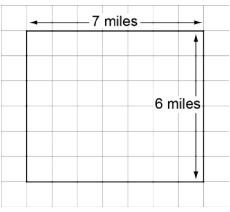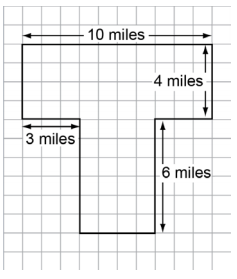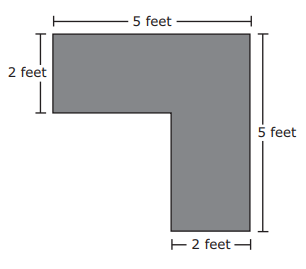- Find the area of a rectangle with whole-number side lengths by tiling it, and show that the area is the same as would be found by multiplying the side lengths.
- Multiply side lengths to find areas of rectangles with whole-number side lengths in the context of solving real world and mathematical problems, and represent whole-number products as rectangular areas in mathematical reasoning.
- Use tiling to show in a concrete case that the area of a rectangle with whole-number side lengths a and b + c is the sum of a × b and a × c. Use area models to represent the distributive property in mathematical reasoning.
- Recognize area as additive. Find areas of rectilinear figures by decomposing them into non-overlapping rectangles and adding the areas of the non-overlapping parts, applying this technique to solve real world problems.
Remarks
Examples of Opportunities for In-Depth FocusArea is a major concept within measurement, and area models must function as a support for multiplicative reasoning in grade 3 and beyond.
Clusters should not be sorted from Major to Supporting and then taught in that order. To do so would strip the coherence of the mathematical ideas and miss the opportunity to enhance the major work of the grade with the supporting clusters.
- Assessment Limits :
Figures are limited to rectangles and shapes that can be decomposed into rectangles. Dimensions of figures are limited to whole numbers. All values in items may not exceed whole number multiplication facts of 10 x 10. - Calculator :
No - Context :
Allowable
- Test Item #: Sample Item 1
- Question:
A park is in the shape of the rectangle shown.

What is the area, in square miles, of the park?
- Difficulty: N/A
- Type: EE: Equation Editor
- Test Item #: Sample Item 2
- Question:
A park is shown.

What is the area, in square miles, of the park?
- Difficulty: N/A
- Type: EE: Equation Editor
- Test Item #: Sample Item 3
- Question:
Specifically for MAFS.3.MD.3.7d:
A drawing of the top of a desk is shown.

What is the area of the top of the desk?
- Difficulty: N/A
- Type: MC: Multiple Choice
Related Courses
Related Access Points
Related Resources
Formative Assessments
Lesson Plans
Original Student Tutorial
Tutorial
Worksheet
STEM Lessons - Model Eliciting Activity
The students will plan a vegetable garden, deciding which kinds of vegetables to plant, how many plants of each kind will fit, and where each plant will be planted in a fixed-area garden design. Then they will revise their design based on new garden dimensions and additional plant options. Students will explore the concept of area to plan their garden and they will practice solving 1 and 2-step real-world problems using the four operations to develop their ideas.
Model Eliciting Activities, MEAs, are open-ended, interdisciplinary problem-solving activities that are meant to reveal students’ thinking about the concepts embedded in realistic situations. Click here to learn more about MEAs and how they can transform your classroom.
In this garden of veggies, students will find the area to determine which vegetable garden beds should be created and where they should be located. Students will submit a letter to the client explaining their procedure for choosing the garden beds and layout.
Model Eliciting Activities, MEAs, are open-ended, interdisciplinary problem-solving activities that are meant to reveal students’ thinking about the concepts embedded in realistic situations. Click here to learn more about MEAs and how they can transform your classroom.
The Shady Oak Treehouse Club is doing a makeover and needs help choosing flooring. Students will be asked to figure area, calculate cost, and add installation fees to cost. The students will then rank the flooring and choose the best one for the makeover. The data provided is: a model of the treehouse (in square yards), flooring price per square yard, and ratings for ease of cleaning and comfort. In the twist, student will be provided with an installation fee for each flooring material and must decide how to change their procedure with the new information.
Model Eliciting Activities, MEAs, are open-ended, interdisciplinary problem-solving activities that are meant to reveal students’ thinking about the concepts embedded in realistic situations. Click here to learn more about MEAs and how they can transform your classroom.
You are a builder who needs to find out what to charge people for rent based on the needs of the different clients and what they might need in an apartment.
Model Eliciting Activities, MEAs, are open-ended, interdisciplinary problem-solving activities that are meant to reveal students’ thinking about the concepts embedded in realistic situations. Click here to learn more about MEAs and how they can transform your classroom.
MFAS Formative Assessments
Students are asked to find the areas of two rectangular figures and are observed to determine if they use multiplication.
Students are presented with a rectangular area model and asked to write an equation that represents the distributive property.
Original Student Tutorials Mathematics - Grades K-5
Learn how tilling can be used to find the area of different rectangular rooms in this interactive tutorial.
Student Resources
Original Student Tutorial
Learn how tilling can be used to find the area of different rectangular rooms in this interactive tutorial.
Type: Original Student Tutorial
Tutorial
In this tutorial video from Khan Academy, students who understand how to count unit squares to find the area of a rectangle can explore the connection between this method and the area formula for rectangles (length times width or base times height).
Type: Tutorial
Worksheet
In this worksheet, students are directed to find the perimeter and area for a clubhouse in the form of rectangles, composite figures, and other polygons. The second sheet urged them to make their own designs for a clubhouse and find the perimeter and area. This resource is recommended as an introduction or review of perimeter and area.
(Found under "Finding Perimeter and Area" on NCTM's Illuminations)
Type: Worksheet
Parent Resources
Tutorial
In this tutorial video from Khan Academy, students who understand how to count unit squares to find the area of a rectangle can explore the connection between this method and the area formula for rectangles (length times width or base times height).
Type: Tutorial









